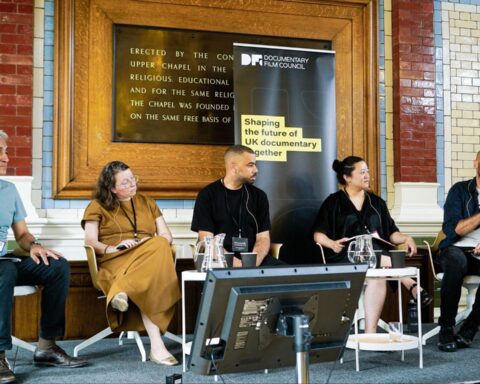The Pearl Button (El Botón de Nácar)
(Chile/France/Spain, 82 min.)
Written and directed by Patricio Guzmán
“They say that water has a memory. I believe it also has a voice,” muses filmmaker Patricio Guzmán (Nostalgia for the Light) in the philosophical voiceover that flows atop The Pearl Button. This poetic film recalls the work of Chris Marker, Peter Mettler, and Jennifer Baichwal with its awesomely stirring visuals and images of the natural landscape. Guzmán wades deep into the complex colonial history of his native Chile as he explores the failure to capitalise on, or adequately cultivate, the immense shorelines that border the nation. 2670 miles of coastline is a lot of area to cover, as is the history of the annihilation of the indigenous groups who first inhabited Chile’s shores, yet Guzmán all but plunges to the depths of Marianas Trench in The Pearl Button’s search for answers.
The button to which the film’s title refers is an effective symbol for the collective devastation of the Kawesqar and Yaghán people of Chilean Patagonia. Guzmán presents two tragedies within his far-reaching odyssey that offers stories of two different pearl buttons that meet similar fates. One tells of a Yaghán man, Orundellico, who was taken from his native Tierra Del Fuego to England at the price of a pearl button. This trade, the film says, earned him the name of Jemmy Button. The film ponders Button’s life abroad as a celebrated second-class citizen to the whites and then as an exile within his own country when he returned and couldn’t relate to his people. It’s a familiar story of the ravages of colonialism, but Guzmán underscores the cost of Button’s life by trailing the currency of pearl buttons along the waters of Chile.
The rate of exchange for a pearl button is equally dire at the film’s end when Guzmán looks at a different button salvaged from the depths of the ocean. It belongs to an anonymous woman who was killed by settlers and cast into the sea with a railway track tied to her as an anchor. Guzmán fails to provide a cogent logical thread between these two stories, but the irony of finding a pearl button as one of the few remaining signifiers of Patagonia’s indigenous culture offers some redemption.
The Pearl Button offers a loose three-act structure as Guzmán ruminates upon the natural, philosophical, and existential elements of water. The first section of the film veers towards experimentation and contemplation as Guzmán considers water as a divine life force. The Pearl Button offers visual poetry as cinematographer Katell Djian captures scenes of nature that frame water as an innocent and uncorrupted character of the Chilean landscape. These shots of oceans, rivers, and ice grace the frame in peculiar angles and perspectives that invite the speculation of Guzmán’s narration.
The film then moves to the stories of the indigenous cultures wiped out by settlers who sought to develop (re: destroy and pillage) the new world. The Pearl Button describes the appreciation for natural elements such as earth and particularly water, within the views of the Kawesqar and Yaghán people, and it argues that the destruction of their cultures illuminates the reasons why Patagonia remains an empty, untapped resource. Guzmán portrays the people with a thoroughly sensitive and inquisitive eye as he interviews some of the surviving members of the tribes. He offers archival photographs and lets the speakers add to the narratives created by the ethnographers. Particularly effective is one sequence in which the filmmaker asks the survivors to speak their own language. The subjects translate words like “water,” “father,” and “mother” from Spanish to Kawesqar, and the emotion is evident on the faces of the subjects as they resurrect a native tongue that has almost entirely vanished. Similarly, one woman corrects Guzmán by informing him that her language has no word for “police,” thus illustrating the difference in philosophies alluded to in the first act.
The third act moves to the story of the dead woman, and it’s here that The Pearl Button struggles to connect its complex range of ideas. The story of the pearl button that belongs to the dead woman doesn’t jive with the narrative of Jemmy Button’s button. As Guzmán extends the musings on water to the murky body of Pinochet and his dictatorship, a few too many ideas begin to swim within The Pearl Button. Images of a cardboard Patagonia appear fleetingly in all three sections and offer the only connective tissue between the stories of the film beyond the pearl button, which is a happy, if effective, coincidence. The stories are all complementary, but there’s a jarring logical gap to the film that doesn’t entirely do justice to the strength of the first two acts.
Ultimately, Guzmán asks for too much leniency from the viewer in his attempt to connect seemingly disparate episodes. While the film’s images are extraordinary and its meditative essay style is noteworthy, The Pearl Button isn’t as effective as Nostalgia for the Light, his previous doc. But even a good film by the Chilean master director is certainly worthy of viewing.
The Pearl Button screened at the Human Rights Watch Film Festival on Thursday, March 31 at TIFF Bell Lightbox.
It opens theatrically at TIFF Bell Lightbox on April 8.
p=.











